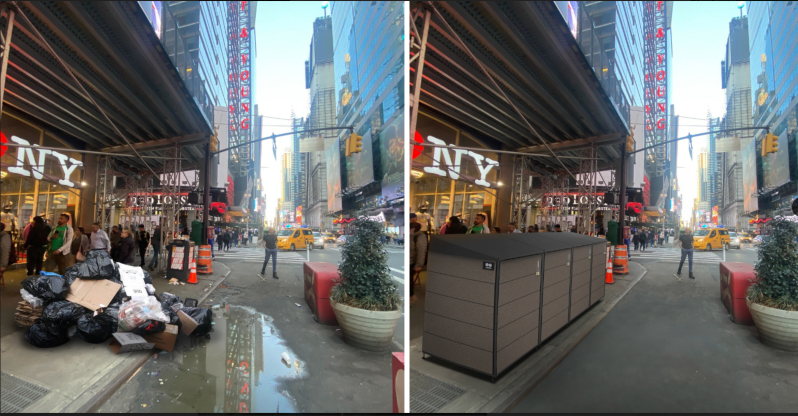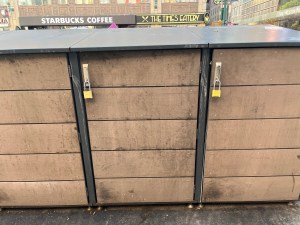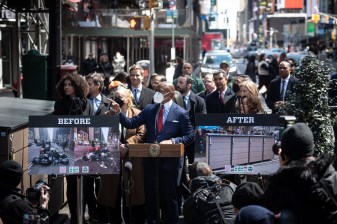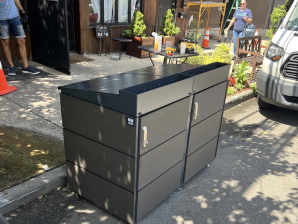Times Square Business Group Pilots Street Trash Enclosures

Garbage in, garbage out — but in a good way!
One of the city’s largest and most influential business improvement districts is helping to bring New York’s garbage collection into the 21st century — by ridding sidewalks of leaky, stinking trash bags with the pioneering use of a street’s curbside lane for a trash enclosure.
The Times Square Alliance will on Tuesday install one such bin in the street at the northwest corner of 43rd and Eighth Avenue (another large enclosure will be in a more conventional location, the sidewalk at Seventh Avenue and 41st Street).
“With 300,000 people once again walking through Times Square, our commitment to clean sidewalks is a priority at the Alliance,” said the group’s president, Tom Harris, referring to the daily foot traffic at the iconic Midtown venue, known as the “Crossroads of the World.”
The four-bin enclosures should not be such a big deal. Municipalities in countries as diverse as Spain, France, South Korea, Argentina, and the Netherlands for decades have used below-ground containers, pneumatic tubes, and sorting bins to keep streets clean and garbage out of pedestrians’ way. But New York, for a variety of reasons, can’t get rid of its famous “5 o’clock shadow” — the mountains of black plastic trash bags on sidewalks walkers must navigate each collection day.
And the city has long been hostile to using the curbside lane of roadways for anything but storage of cars. In fact, when a group of Hells Kitchen activists created a corral in a “parking” space on W. 38th Street two years ago, the Department of Transportation sent a cease-and-desist letter.
So this time around, the enclosures are a big deal, and happened with the assistance of the departments of Sanitation and Transportation and Small Business Services, and the district’s Council member, Erik Bottcher.
The Times Square enclosures are the inaugural project of Clean Curbs, a two-year-old collaboration between the departments of Sanitation and Transportation. The program, which was slow to get off the ground because of the pandemic, has both commercial and residential components. The commercial component, which started first, has several potential projects in the pipeline. The residential component, which will use the curb of one Manhattan block with enclosures used by several apartment buildings, should debut in a few months, said DSNY spokesman Joshua Goodman. The Alliance is paying for its enclosures, which cost a bit more than $9,000 each.
“On-street containerized trash is an idea whose time has come in New York City,” said Bottcher, member of the Council’s Sanitation Committee. “It’s especially needed in dense, highly trafficked areas. I’m excited that the Clean Curbs program is coming to Times Square and look forward to having it expanded to more areas soon.”
The Times Square development follows a larger trend in municipal public-realm management, in which business improvement districts — public-private partnerships that aren’t hampered by city contracting rules — are pushing ahead of the city bureaucracies in important public functions, such as pedestrianization. BIDs have stepped into the breach on sanitation and security in many commercial districts for decades — forced by the attenuation of public services that started with the city’s 1970s fiscal crisis. Often, the BIDs and the city will work in tandem, such as in the efforts to create plazas and “shared streets” north of Madison Square and in the Flatiron District. Sometimes, BIDs have innovated quietly without city backing. The chic and forward-thinking Meatpacking Business Improvement District, for example, informally has operated a trash corral in the street on Ninth Avenue for some time.
Founded in 1992 in the wake of the city’s decades-long, pitched effort to “clean up” the red-light district of Times Square, the Alliance covers most territory from W. 40th to 53rd streets between Sixth and Eighth avenues, including the Theater District and Restaurant Row (W. 46th Street between Eighth and Ninth avenues). It spent about $5.6 million and has 70 employees on supplementary sanitation in 2021, out of a $20.3-million budget.
CITIBIN, which fabricated the Alliance’s enclosures of aluminum clad in a bamboo composite used in outdoor decking, has positioned itself to capitalize on Clean Curbs and other city programs. A small, woman-owned business, it grew out of a custom handiwork firm started a decade ago by Park Slope resident Liz Picarazzi, who began getting orders from clients who wanted rat-proof solutions for residential trash or to replace dilapidated enclosures. Last year, the business, which employs six people full time and sells half its product to single-family homes and half to property managers and developers, broke $1 million in sales.
“I’m a New Yorker,” declared Picarazzi, who has marketed her product with amusing videos such as “Experiment: #PizzaRat versus CITIBIN.” “I want to see these things cleaned up!”
Goodman stressed, however, that, given the many hundreds of tons of waste produced daily by New Yorkers, trash enclosures are “not a silver-bullet solution” for the sidewalk-trash problem. “The only way to have there be less trash is for people to produce less trash,” he added, “and any New Yorker who is concerned about trash set out on the sidewalk should also do their part to reduce the amount of waste produced each day.”





